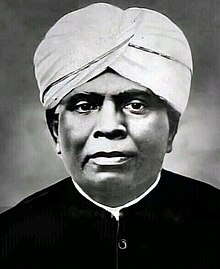Kalingalmadom Rarichan Moopan
The Kallingal Madathil Rarichan Moopan (1856–1919) was a prominent figure in Kozhikode.[1][2][3] The Jenmi or landlord of the land is Kallingal Madam Rarichan Moopan.[4][5][6]Rarichan moopan was one of the prominent social reformer of Malabar.[7][8]He is one of the most notable Social Reformer in Kozhikode and is also known for his community development and other social services.
Kallingal Madathil Rarichan Mooppan | |
|---|---|
 Kallingal Madathil Rarichan Mooppan | |
| Personal | |
| Born | 1856 |
| Died | 1913 |
| Religion | Hinduism |
| Nationality | Indian, Kerala Region |
| Philosophy | Social Reformer |
| Religious career | |
| Literary works | Thiyofication founded |
| Quote | The whole universe is one mind. Between mind and mind there is no vacuum. |
Biography[]
Rarichan Mooppan (Kallingal Madathil) Born in Kozhikode on the 1856 February 20, he completed his matriculation. He married the sister of Mithavaadi Krishnan, and worked as a mixed-race, social reformer and community benefactor. He worked in front to build a temple for the backward classes in Kozhikode and gave land.[9]The elders of that time were the wealthiest of the Kallingal Madam after the Kozhikode Zamorin.[6][10][11][3] The pullambil Moopan's family of thalassery and the families Kallingal moopan too seem to have engaged in sea trade on an extantion scale.[12][13]Rarichan Moopan is a man who worked for the construction of the Sri Kandeshwara Temple in Kozhikode under the leadership of Rarichan Moopan and Moorkoth Kumaran. The temple was donated by the Kallingal family.[3]
personal life[]
They had extensive knowledge of shipbuilding and navigation. In the Malabar region, there were several families, each headed by a Mooppan (patriarch) highly respected by the mercantile community in Kerala and abroad, for their entrepreneurship and extensive international trade. Some of the prominent members of the circle of these patriarchs were Vamala Mooppan, Kelu Mooppan, Pullampil Mooppan, Vayayil Mooppan and Kallingkal Mooppan.[14]One of the Mooppan families surviving with all its splendour is of Rarichan Mooppan of Kallingkal Madathil who owned and possessed vast landed property in Calicut and continued with his sea trade till the first quarter of the 20th century. The Mooppans together had the best mercantile marine like of which no private individuals in India had owned during their time.[15]
The Kallingkal Madam also contributed one of the towering intellectuals of the 20th century C. Krishnan, the editor of the revolutionary journal Mitavadi (moderate).[14] As given in their records and documents an landlord house, the Kallingkal Madam was one of the leading shipowners and marine traders and for their ships there had been provided a separate dock in Arabia. The ships of these Mooppans (patriarchs) carried from Kerala and in fact, from the sea board up to Konkan, a vide variety of cargo, timber, spices, copra, elephant tusks, cured fish, rice, millet, peacock-feather and animal skins, woven cloth and handicrafts. In turn they brought dates to their land and traded myrrh.[14][16][17][18][19]
References[]
- ^ "Journal of Kerala Studies". University of Kerala. July 3, 1982 – via Google Books.
- ^ P.K.Balakrishnan. (1960), "Narayanaguru", sahithya pravarthaka co operative, google books p.94
- ^ a b c Changaram Kumarathsankaran, "C.Krishnan" (1967).Sidhartha Books House, google books, page.57-57-91
- ^ Anima, P. (January 25, 2013). "A quick buy". The Hindu – via www.thehindu.com.
- ^ A.Ayyappan (1965). Social Revelotion in a Kerala Village:A Study in Culture Change. Asia Publishing House. p. 121.
- ^ a b Hiroyuki Kotani (1997). caste System, Untetublity, and the Depressed. Manohar Publisher. p. 151. ISBN 9788173042041.
- ^ Parameswaran, P. (July 3, 1979). "Narayana Guru, the Prophet of Renaissance". Suruchi Sahitya – via Google Books.
- ^ "ചരിത്രരേഖകളിലെ ദീപസ്തംഭങ്ങള്". Deshabhimani.
- ^ Gopal, Krishna (2003). Fairs and Festivals of India: Andaman and Nicobar Islands, Kerala, Lakshadweep, Pondicherry, Tamil Nadu. ISBN 9788121208093.
- ^ M.Gangadhara Menon (1989). Malabar Rebellion, 1921,1922. Vohra publisher. p. 139. ISBN 9788185072494.
- ^ Vāsavappaṇikkar, Kumpaḷañcirayil Si (July 3, 1944). "Sarasakavi Mūlūr Ess. Patmanābhappaṇikkar: oru ānukālikāvalōkanaṃ". Apēkṣikkēṇṭum mēlvilāsaṃ, Vāsavappaṇikkar – via Google Books.
- ^ university of kerala, (1982)Journey of Kerala study p.127
- ^ North Africa to North Malabar: AN ANCESTRAL JOURNEY. ISBN 9789383416646. (2012)
- ^ a b c S.N.Sadasivan (2000). A Social History of India. p. 353. ISBN 9788176481700.
- ^ S.N Sadasivan(2000)
- ^ കോളേജ്, എം സി വസിഷ്ഠ് അസോസിയേറ്റ് പ്രൊഫസർ ചരിത്രവിഭാഗം മലബാർ ക്രിസ്ത്യൻ. "കോഴിക്കോട്ടുകാർ മറന്നുപോയ രാരിച്ചൻ മൂപ്പൻ". Mathrubhumi.
- ^ "Birth of Mathrubhumi". archives.mathrubhumi.com.
- ^ Tharathamyapathanasangham. (1999), "500 Varshatte Keralam" (Malayalam). Collection of articles on the culture study of the kerala, India ISBN 9788187378020
- ^ M.Gangadhara Menon (1989). Malabar Rebellion. Vohra publishing. p. 139. ISBN 9788185072494.
This article needs additional or more specific categories. (July 2021) |
- Businesspeople from Kozhikode
- 1856 births
- 1919 deaths